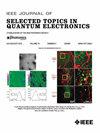Experimental Characterization of Optical Fiber Bundles for Free-Space Optical Communication in High-Altitude Platforms
IF 5.1
2区 工程技术
Q1 ENGINEERING, ELECTRICAL & ELECTRONIC
IEEE Journal of Selected Topics in Quantum Electronics
Pub Date : 2025-09-08
DOI:10.1109/JSTQE.2025.3607094
引用次数: 0
Abstract
Optical fiber bundles (FBs) can offer significant benefits in the design of free-space optical communication systems. Until now, their primary use has been for imaging of difficultto- access areas in medical and chemical applications. This work explores the optical and communication properties of FBs as light guiders to connect multiple optical heads to a central laser communication terminal in high altitude platforms, specifically, on the properties of FBs as part of a receiver module. We characterize the optical properties of a 1.829 m-long FB from Schott AG, designed for image guiding of visible wavelengths, both at 850 nm and at 1550 nm. A 1.25 Gbit/s data transmission using on-off keying modulation at 1550 nm is demonstrated with bit error ratio (BER) measurements. To evaluate the impact of atmospheric turbulence, a spatial light modulator is used to simulate an air-to-air optical link between two aircrafts at an altitude of 10 km, separated by 20 km. Including transmission losses, to achieve a BER of高空平台自由空间光通信光纤束的实验表征
光纤束在自由空间光通信系统设计中具有重要的优势。到目前为止,它们的主要用途是在医疗和化学应用中难以进入的区域进行成像。本工作探讨了FBs作为光导器的光学和通信特性,将多个光学头连接到高海拔平台的中央激光通信终端,特别是作为接收器模块一部分的FBs的特性。我们对Schott AG公司设计的用于850 nm和1550 nm可见波长图像引导的1.829 m长FB的光学特性进行了表征。通过误码率(BER)测量,演示了在1550 nm下使用开关键控调制的1.25 Gbit/s数据传输。为了评估大气湍流的影响,使用空间光调制器来模拟两架飞机之间的空对空光学链路,高度为10公里,相隔20公里。包括传输损耗在内,为了实现$10^{-6}$的误码率,与没有它的光链路相比,FB在没有湍流的情况下引入了6.55 dB的链路预算损失,在湍流条件下引入了7.94 dB。通过优化材料选择,期望FB在红外c波段的性能得到进一步改善。
本文章由计算机程序翻译,如有差异,请以英文原文为准。
求助全文
约1分钟内获得全文
求助全文
来源期刊

IEEE Journal of Selected Topics in Quantum Electronics
工程技术-工程:电子与电气
CiteScore
10.60
自引率
2.00%
发文量
212
审稿时长
3 months
期刊介绍:
Papers published in the IEEE Journal of Selected Topics in Quantum Electronics fall within the broad field of science and technology of quantum electronics of a device, subsystem, or system-oriented nature. Each issue is devoted to a specific topic within this broad spectrum. Announcements of the topical areas planned for future issues, along with deadlines for receipt of manuscripts, are published in this Journal and in the IEEE Journal of Quantum Electronics. Generally, the scope of manuscripts appropriate to this Journal is the same as that for the IEEE Journal of Quantum Electronics. Manuscripts are published that report original theoretical and/or experimental research results that advance the scientific and technological base of quantum electronics devices, systems, or applications. The Journal is dedicated toward publishing research results that advance the state of the art or add to the understanding of the generation, amplification, modulation, detection, waveguiding, or propagation characteristics of coherent electromagnetic radiation having sub-millimeter and shorter wavelengths. In order to be suitable for publication in this Journal, the content of manuscripts concerned with subject-related research must have a potential impact on advancing the technological base of quantum electronic devices, systems, and/or applications. Potential authors of subject-related research have the responsibility of pointing out this potential impact. System-oriented manuscripts must be concerned with systems that perform a function previously unavailable or that outperform previously established systems that did not use quantum electronic components or concepts. Tutorial and review papers are by invitation only.
 求助内容:
求助内容: 应助结果提醒方式:
应助结果提醒方式:


